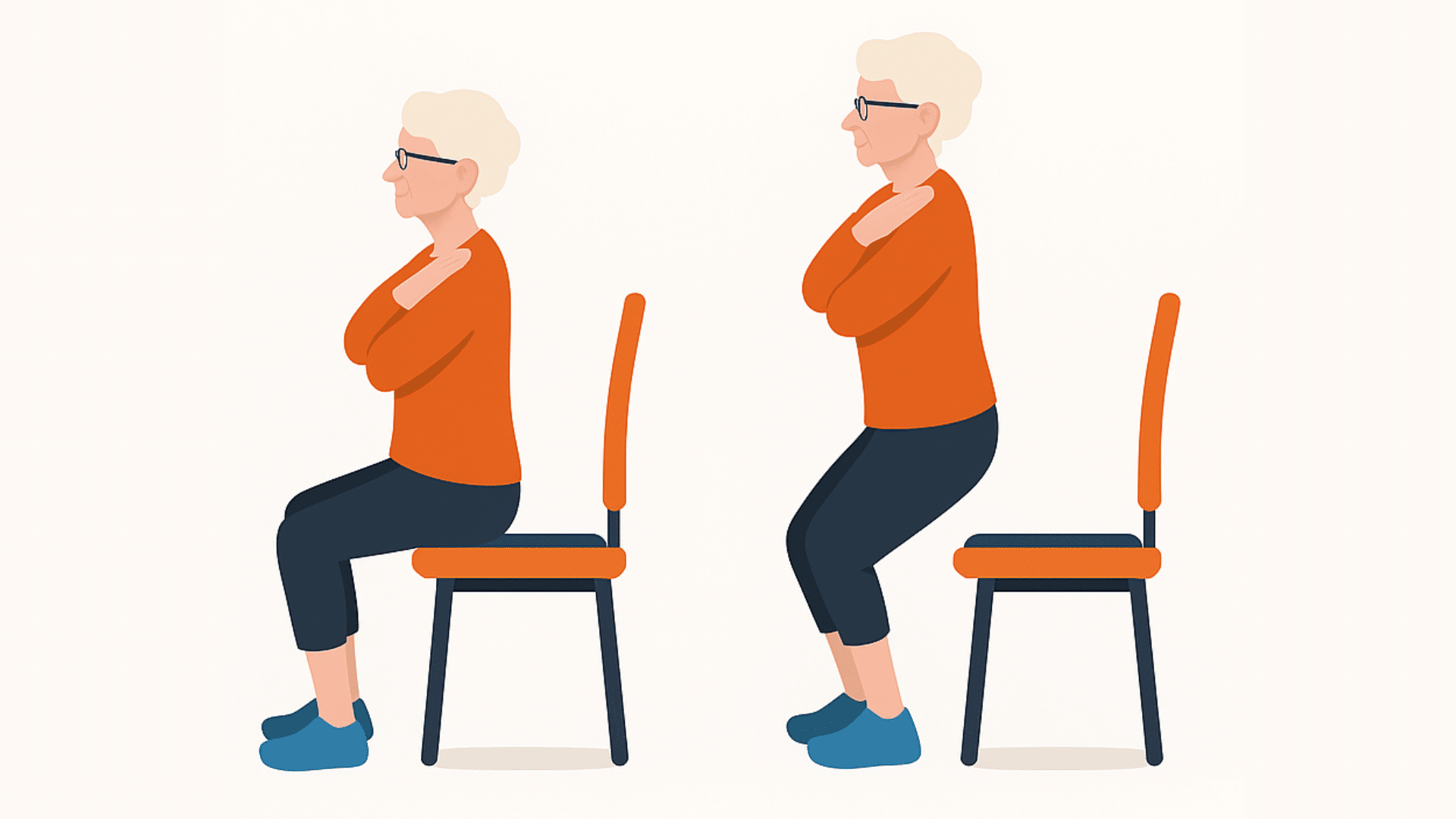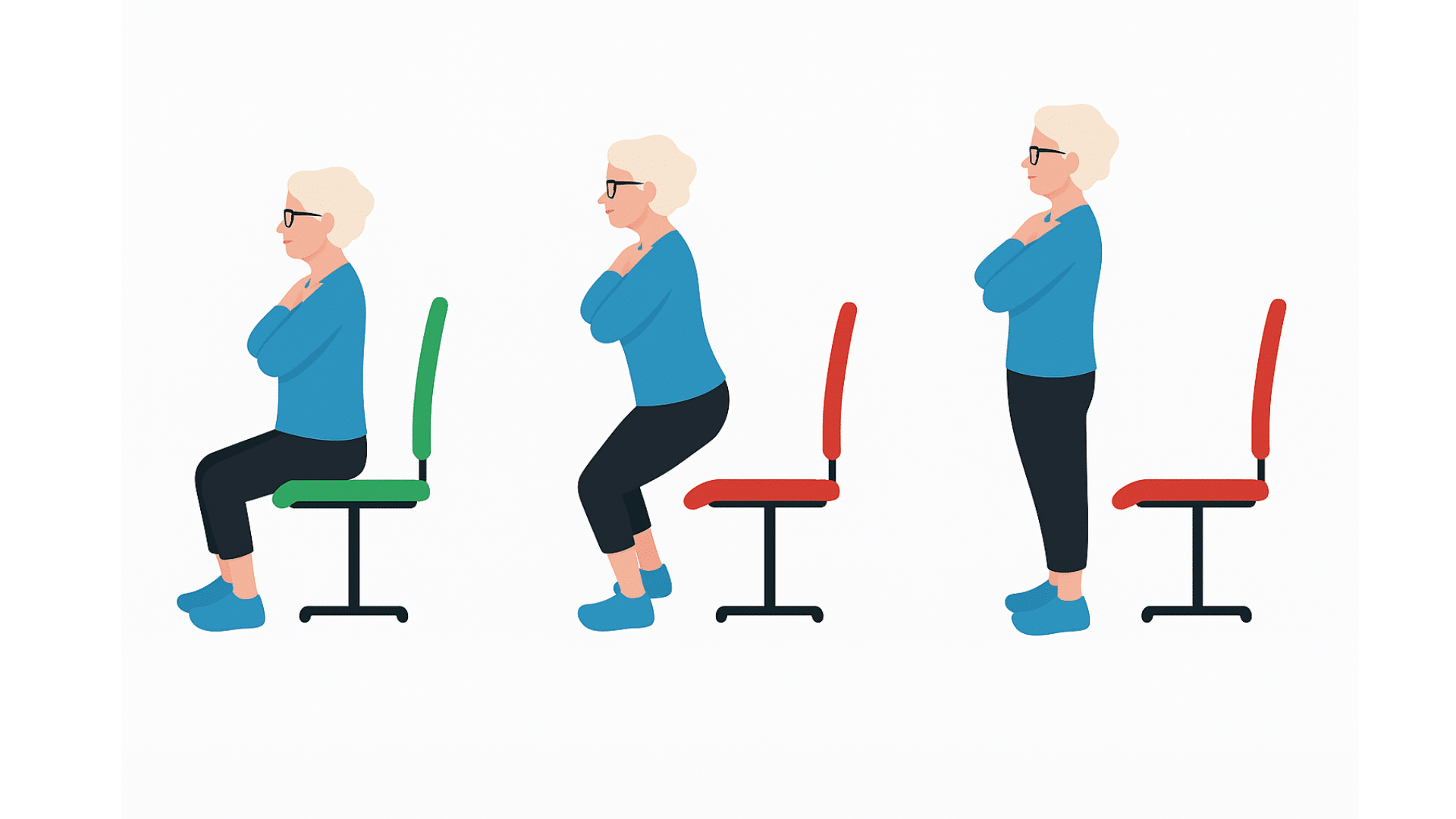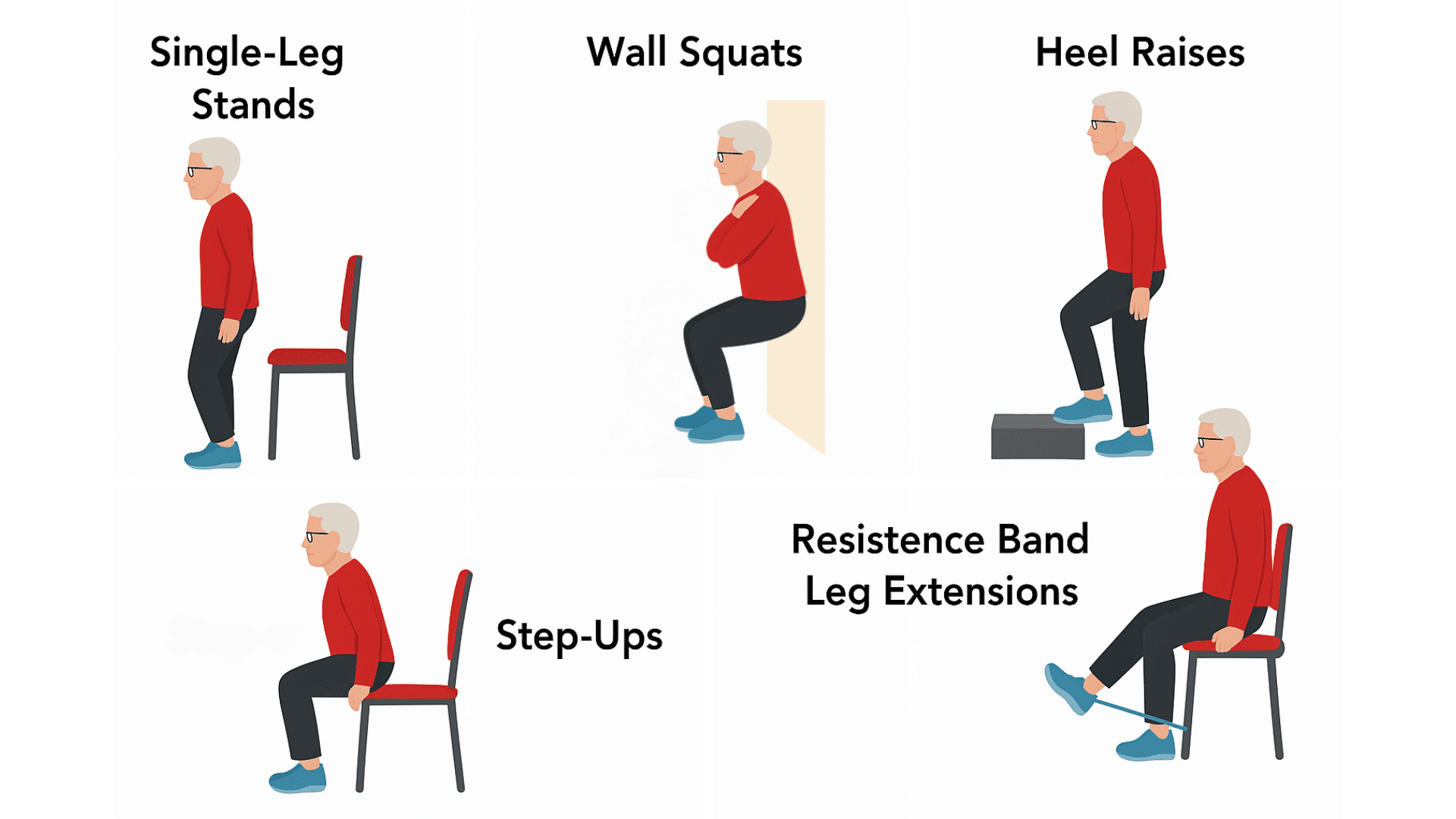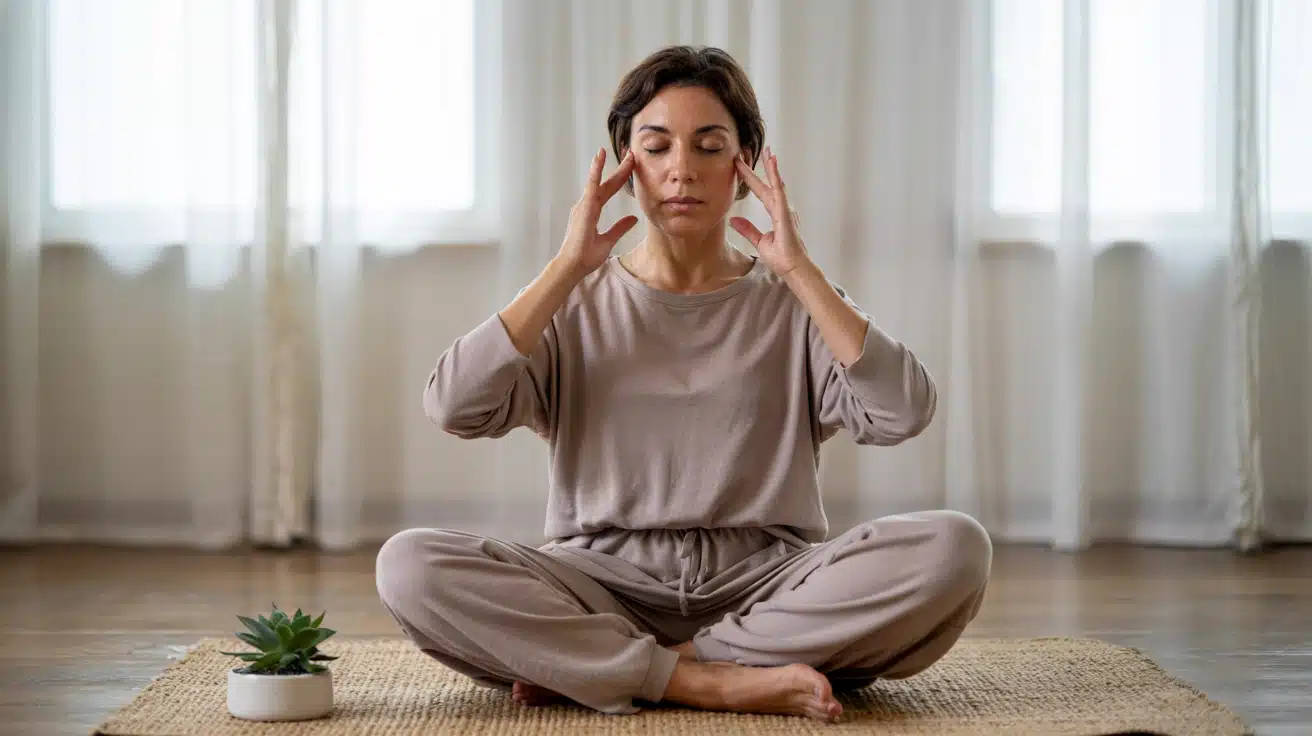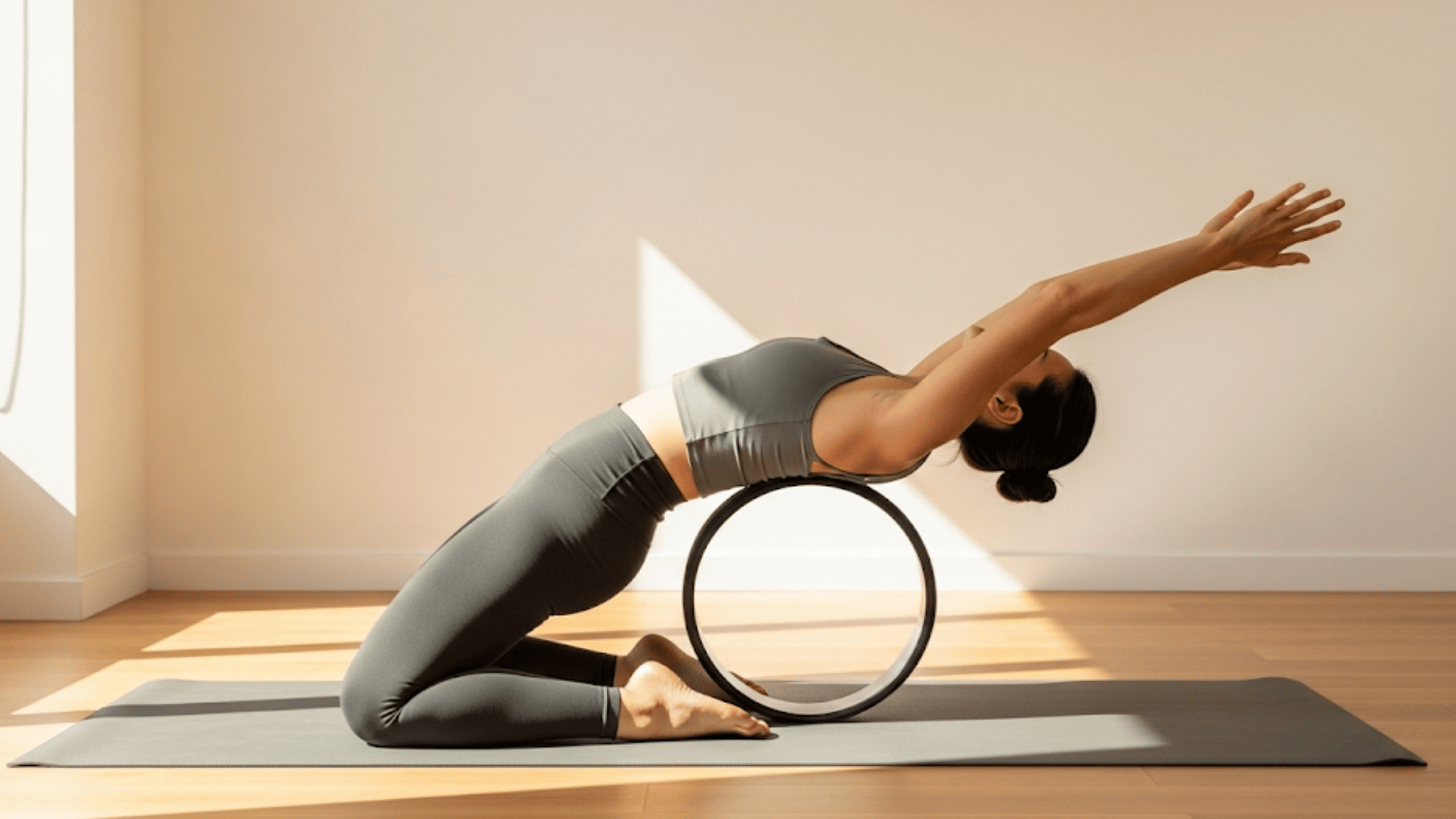Getting up from a chair without using your hands might seem simple, but for many adults over 50, this basic movement becomes increasingly difficult.
As lower body strength declines by 12-15% each decade after age 50, daily tasks like rising from chairs, getting out of cars, or climbing stairs become real challenges.
The good news?
Health tests like the 30-second sit-to-stand test offer a quick way to assess your body’s health condition. This is as simple as an assessment that takes just half a minute but provides valuable insights about your body.
In this guide, you’ll learn exactly how to perform the test at home, understand what your results mean, and get a proven exercise plan to improve your score and maintain your independence as you age.
What Is the 30-sec Sit to Stand Test?
The 30-second chair stand test is a simple mobility assessment that measures lower body strength and endurance. It involves standing up and sitting down from a chair as many times as possible in 30 seconds.
Originally part of the Senior Fitness Test battery, it serves as both a fall risk screening tool and a way to track muscle power measurement in aging over time.
The test mimics daily movements like rising from a chair or toilet, essential for maintaining independence.
Healthcare professionals and fitness experts use this tool to identify individuals who may benefit from strength training or fall prevention programs.
Benefits of the 30 STS Test
Standing up without using your hands requires coordination, balance, and muscle strength.
Lower body strength typically declines by 12–15% per decade after age 50, increasing fall risk and affecting daily activities.
Strong legs help you:
- Navigate stairs – Climb up and down without strain or assistance
- Get in and out of cars – Transfer between sitting and standing positions easily
- Rise from low surfaces – Stand up from chairs and couches without using your hands
- Maintain balance – Stay steady while walking and changing directions
- Prevent falls – React quickly to trips and regain your footing
Poor performance on this sit-to-stand test for the elderly often predicts future mobility issues, hospitalizations, and loss of independence, making it a crucial early warning system for potential health problems.
Who Should Perform the 30 STS Test?
| Who Should Take It | Why |
|---|---|
| Older Adults (60+) | Track strength changes and identify decline early; establish baseline scores. |
| People with Arthritis | Monitor muscle strength and mobility; track treatment effectiveness. |
| Recovery Patients | Monitor progress after surgery, hospitalization, or extended bed rest. |
| Those with Balance Concerns | Quantify current strength levels; guide exercise recommendations. |
| Fitness Enthusiasts | Track strength as part of overall fitness monitoring, especially with aging. |
How to do the 30-sec Sit to Stand Test at Home?
To get the most accurate results and ensure your safety, it’s important to follow each step carefully.
Follow these steps to know exactly how to perform the 30-second Sit to Stand Test the right way.
Step 1: Set Up Your Environment
-
Place the chair on a non-slip surface, like carpet, or use a rubber mat.
-
Position the chair against a wall for extra stability.
-
Make sure you’re wearing comfortable clothing and flat shoes for safety.
Step 2: Get Into Position
-
Sit in the center of the chair.
-
Keep your feet flat on the floor, about shoulder-width apart.
-
Position your knees at a 90-degree angle or slightly behind your knees for extra power.
-
Cross your arms over your chest — place each hand on the opposite shoulder. (No pushing off with hands!)
-
Sit upright with your back straight and buttocks touching the chair fully.
Step 3: Start the Test
On the word “Go”, start standing up:
-
Push through your heels.
-
Stand all the way up until your knees and hips are fully extended.
Immediately sit back down until your buttocks touch the chair. Repeat this stand and sit cycle as many times as possible in 30 seconds.
Your helper should:
-
Start the timer as you begin moving.
-
Count only complete cycles — standing fully upright and sitting fully down.
Visual Representation of Performing 30-sec Sit to Stand Test
I’d like to acknowledge EducatedPT for the insightful video, which is taken as a key reference for the visual representation here.
Safety Guidelines During 30-sec Sit-to-Stand Test
- If you feel pain, dizziness, or shortness of breath, stop immediately.
- Maintain crossed arms throughout the test. If crossing arms is too difficult initially, place them lightly on your lap, but avoid pushing off the chair.
- Your helper can cheer you on, but shouldn’t provide physical assistance unless you’re at risk of falling
What to Do After Recording a 30-Second Sit-to-Stand Test?
Record your total number of complete stand-sit cycles. Compare your result to normative values based on your age and gender.
Use the score as a baseline for tracking progress over time or for discussing fitness goals with healthcare providers.
30-Second Chair Stand Test Norms
Understanding how your results compare to others in your age group helps you assess your lower body strength and identify areas for improvement.
For Senior Women
| Age Range | Average | Above Average |
|---|---|---|
| 60–64 | 12–17 | >17 |
| 65–69 | 11–16 | >16 |
| 70–74 | 10–15 | >15 |
| 75–79 | 10–15 | >15 |
| 80–84 | 9–14 | >14 |
| 85+ | 8–13 | >13 |
For Older Men
| Age Range | Average | Above Average |
|---|---|---|
| 60–64 | 14–19 | >19 |
| 65–69 | 12–18 | >18 |
| 70–74 | 12–17 | >17 |
| 75–79 | 11–17 | >17 |
| 80–84 | 10–15 | >15 |
| 85+ | 8–14 | >14 |
For senior citizens, these score means:
- Above Average: Strong lower-body strength, low fall risk.
- Average: Typical strength, potential for improvement.
- Below Average: Higher fall risk, need for strength training.
Young Adults
| Age Range | Average | Above Average |
|---|---|---|
| 20–29 | 25–35 | >35 |
| 30–39 | 22–32 | >32 |
| 40–49 | 20–30 | >30 |
| 50–59 | 18–28 | >28 |
For young adults, these score means:
- Above Average: Excellent muscular endurance and power.
- Average: Good strength, could improve with training.
- Below Average: Indicates weaker strength; may affect daily function long-term.
Best Exercises to Improve Sit-to-Stand Performance
Building strength for the 30-second sit-to-stand test requires focused training of your quadriceps, glutes, hamstrings, and core muscles.
Improving your performance boosts your test score and enhances daily mobility, balance, and independence. Here are the most effective exercises to strengthen these crucial muscle groups:
1. Wall Squats
Strengthens your quads, hamstrings, and glutes while promoting proper posture and building endurance for multiple repetitions.
Steps to perform wall squats:
- Stand with your back against a wall, feet hip-width apart
- Slide down into a squat position with knees above ankles
- Keep your thighs parallel to the floor if possible
- Hold for 15–30 seconds, then slide back up
- Complete 2–3 sets
Pro tip: Start with shorter holds and gradually increase time as your strength improves.
2. Step-Ups
Improves leg strength, coordination, and balance — all essential components for powerful stand-ups during the test.
Steps to perform step-ups:
- Find a sturdy step or a low platform
- Step up with one foot, bring the other foot up completely
- Step down one foot at a time
- Perform 10 repetitions per leg
Pro tip: Begin with a low step and use a handrail for support if needed. Increase step height as you progress.
3. Heel Raises
Strengthens calf muscles, which are crucial for stability and balance during standing movements.
Steps to perform heel raises:
- Stand behind a chair for balance support
- Raise your heels off the ground, standing on your toes
- Hold for 2 seconds at the top, then lower slowly
- Complete 2 sets of 15 repetitions
Pro tip: Challenge yourself by performing them on one leg once you build sufficient strength.
4. Single-Leg Stands
Enhances balance and strengthens stabilizer muscles, reducing your risk of falls during daily activities.
Steps to perform single-leg stands:
- Stand on one leg while holding onto a chair or counter for support
- Keep your standing leg straight and engaged
- Hold for 30 seconds per leg
Pro tip: Gradually reduce hand support and increase hold time as your balance improves.
5. Resistance Band Leg Extensions
Adds controlled resistance to your training for faster strength gains, specifically targeting the quadriceps muscles.
Steps to perform resistance band leg extensions:
- Attach a resistance band to a sturdy object and loop it around your ankle
- Sit in a chair and extend your leg forward slowly against the resistance
- Control the return movement
- Perform 10–12 repetitions per leg
Pro tip: Adjust the band’s resistance level as your strength improves to maintain an appropriate challenge.
Weekly Guide to Strengthen Sit-to-Stand Performance
This approach creates a mini training plan that changes random exercises into a focused, goal-oriented program. The structured routine steadily builds strength, balance, and functional mobility.
Weeks 1–2: Practice assisted chair stands (3 sets of 5–8 reps), wall squats (2 sets of 10), daily balance practice (30 seconds per leg).
Weeks 3–4: Progress to unassisted chair stands (3 sets of 8–12 reps), step-ups (2 sets of 10 per leg), heel raises (2 sets of 15).
Weeks 5–6: Add fast chair stands (3 sets of 10), higher step-ups with added resistance, and practice the actual test twice weekly.
Note: Exercise 3–4 days per week. Focus on proper form over speed. Increase repetitions before adding resistance or difficulty.
These improvements help you ace the sit-to-stand test and, more importantly, maintain your independence and mobility in daily life.
When to Retest the 30-sec STS Test?
Retest every 3–6 months for regular monitoring. After completing an exercise program to measure improvement.
Following recovery from illness, track the return of strength. Anytime you notice strength changes in daily activities.
This senior fitness self-assessment helps maintain independence. Regular use of mobility tests for seniors reduces fall risk when combined with appropriate exercise programs.
The test serves as both a screening tool and motivation for continued strength training as part of healthy aging.
Conclusion
The 30-second sit-to-stand test is more than just a fitness assessment; it’s your personal mobility report card.
By testing yourself every 3-6 months, you can catch strength decline early and take steps to address it before it affects your daily life.
Remember, poor scores aren’t permanent. With consistent training using chair stands, wall squats, and step-ups, most people see improvement within 4-6 weeks.
The key is starting where you are and progressing gradually. Strong legs mean confident living. They help you climb stairs without worry, get up from low chairs easily, and reduce your fall risk significantly.
Take the test today, note your baseline score, and start building the strength that keeps you independent. Let me know in the comments below what your test score is!
Your future self will thank you for the effort you put in now.

